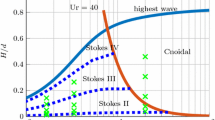Abstract
This paper presents the design concept of a hinged-type wave energy converter, Sea Wave Energy Extraction Device (SeaWEED), and associated numerical and experimental studies of its performance in regular waves. The device is considered as an improved attenuator. A SeaWEED unit consists of four modules that are connected by rigid truss structures. The four-module array includes a non-energy producing nose module in the front, followed by two energy producing modules, and another non-energy producing module at the rear. A potential-flow-based time-domain program with the Lagrange multiplier approach was developed to simulate the dynamics of multiple constrained bodies. Model tests of a 1:35 scale model with and without the power take-off (PTO) units were carried out to validate the numerical method. Friction dampers were designed and manufactured to mimic the PTO units. The validated time-domain method was applied to predict the absorbed power by the device in regular waves.














































Similar content being viewed by others
References
A. Pecher, J.P. Kofoed, Handbook of Ocean Wave Energy (Springer, London, 2017)
A.H. Day, A. Babarit, A. Fontaine, Y.-P. He, M. Kraskowski, M. Murai, I. Penesis, F. Salvatore, H.-K. Shin, Hydrodynamic modelling of marine renewable energy devices: a state of the art review. Ocean Eng. 108, 46–69 (2015)
J.P. Kofoed, P. Frigaard, E. Friis-Madsen, H.C. Sørensen, Prototype testing of the wave energy converter wave dragon. Renew. Energy 31(2), 181–189 (2006)
S. Parmeggiani, J.P. Kofoed, E. Friis-Madsen, Experimental update of the overtopping model used for the wave dragon wave energy converter. Energies 6(4), 1961–1992 (2013)
W. Sheng, R. Alcorn, A. Lewis, Assessment of primary energy conversions of oscillating water columns. II Power take-off and validations. J. Renew. Sustain. Energy 6(5), 053114 (2014)
A. Bjerrum, The wave star energy concept, in 2nd International Conference on Ocean Energy (Brest, France, 2008)
D.J. Pizer, C.H. Retzler, R.W. Yemm, The OPD Pelamis: experimental and numerical results from the hydrodynamic work program, in 4th European Wave Energy Conference (Aalborg, Denmark, 2000), pp. 227–234
P. Stansby, E.C. Moreno, T. Stallard, A. Maggi, Three-float broad-band resonant line absorber with surge for wave energy conversion. Renew. Energy 78, 132–140 (2015)
L. Sun, P. Stansby, J. Zang, E.C. Moreno, P.H. Taylor, Linear diffraction analysis for optimisation of the three-float multi-mode wave energy converter \(M4\) in regular waves including small arrays. J. Ocean Eng. Mar. Energy 2(4), 429–438 (2016)
L. Sun, J. Zang, P. Stansby, E.C. Moreno, P.H. Taylor, R.E. Taylor, Linear diffraction analysis of the three-float multi-mode wave energy converter \(M4\) for power capture and structural analysis in irregular waves with experimental validation. J. Ocean Eng. Mar. Energy 3(1), 51–68 (2017)
S.H. Salter, Wave power. Nature 249(5459), 720–724 (1974)
L.J. Duckers, F.P. Lockett, B.W. Loughridge, A.M. Peatfield, M.J. West, P.R.S. White, Optimisation of the clam wave energy converter. Renew. Energy 5(5), 1464–1466 (1994)
J. Weber, F. Mouwen, A. Parish, D. Robertson, Wavebob-research & development network and tools in the context of systems engineering, in 8th European Wave and Tidal Energy Conference (Uppsala, Sweden, 2009)
M. Mekhiche, K. A. Edwards, Ocean power technologies power buoy: system-level design, development and validation methodology, in 2nd Marine Energy Technology Symposium (Seattle, America, 2014)
S.A. Noren, Plant for utilizing kinetic energy. US Patent (1981)
A. Babarit, A. H. Clément, J.-C. Gilloteaux, Optimization and time-domain simulation of the SEAREV wave energy converter, 24th International Conference on Offshore Mechanics and Arctic Engineering (Halkidiki, Greece, 2005), pp. 703–712
S.-H. Yang, J.W. Ringsberg, E. Johnson, Z. Hu, L. Bergdahl, F. Duan, Experimental and numerical investigation of a taut-moored wave energy converter: a validation of simulated buoy motions. Proc. Inst. Mech. Eng. Part M 232(1), 97–115 (2018)
X.L. Zhao, D.Z. Ning, D.F. Liang, Experimental investigation on hydrodynamic performance of a breakwater-integrated WEC system. Ocean Eng. 171, 25–32 (2019)
Y. Li, H. Peng, W. Qiu, B. Lundrigan, T. Gardiner, Hydrodynamic analysis and optimization of a hinged type wave energy converter, 35th International Conference on Ocean (Offshore and Arctic Engineering, Busan, South Korea, 2016)
J.N. Newman, Wave effects on deformable bodies. Appl. Ocean Res. 16(1), 47–59 (1994)
M. Ó’Catháin, B.J. Leira, J.V. Ringwood, J.-C. Gilloteaux, A modelling methodology for multi-body systems with application to wave-energy devices. Ocean Eng. 35(13), 1381–1387 (2008)
D. Baraff, Linear-time dynamics using Lagrange multipliers, 23rd Annual Conference on Computer Graphics and Interactive Techniques (New Orleans, America, 1996), pp. 137–146
L. Sun, R.E. Taylor, Y.S. Choo, Responses of interconnected floating bodies. IES J. Part A 4(3), 143–156 (2011)
X. Feng, W. Bai, Hydrodynamic analysis of marine multibody systems by a nonlinear coupled model. J. Fluids Struct. 70, 72–101 (2017)
D.J. Pizer, C. Retzler, R.M. Henderson, F.L. Cowieson, M.G. Shaw, B. Dickens, R. Hart, Pelamis WEC-recent advances in the numerical and experimental modelling programme, 6th European Wave and Tidal Energy Conference (Glasgow, UK, 2005)
D. G. Danmeier, A higher-order method for large-amplitude simulations of bodies in waves, Ph.D. thesis, Massachusetts Institute of Technology (1999)
W. Qiu, H. Peng, Numerical solution of body-exact problem in the time domain. J. Ship Res. 57(1), 13–23 (2013)
A. Witkin, An introduction to physically based modelling: Constrained dynamics (Robotics Institute, Carnegie Mellon University, SIGGRAPH course notes, 1997)
Acknowledgements
This work was supported by National Research Council of Canada (NRC)’s Industrial Research Assistance Program (IRAP), Grey Island Energy Inc., and the Natural Sciences and Engineering Research Council of Canada (NSERC).
Author information
Authors and Affiliations
Corresponding author
Additional information
Publisher's Note
Springer Nature remains neutral with regard to jurisdictional claims in published maps and institutional affiliations.
Rights and permissions
About this article
Cite this article
Peng, H., Qiu, W., Meng, W. et al. Experimental studies and time-domain simulation of a hinged-type wave energy converter in regular waves. Mar Syst Ocean Technol 15, 1–15 (2020). https://doi.org/10.1007/s40868-020-00073-5
Received:
Accepted:
Published:
Issue Date:
DOI: https://doi.org/10.1007/s40868-020-00073-5




